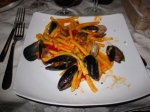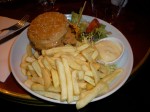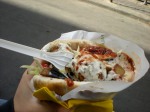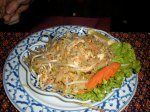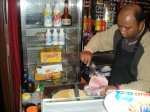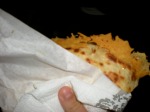A disclaimer before you start reading: this post varies a little bit from my usual style/topics, but read on if you’re interested…
When I selected my living arrangements for the summer, I made what I will now admit was not a very well thought out decision. It was late in the summer housing game, so I urgently sought out an apartment or dorm room based on very simple criteria (clean, safe, AC so I wouldn’t fry). All my previous interactions with New York had involved tourist attractions, and the penthouse suite at the Empire State Building was out of my price range, so I found myself entirely clueless about which neighborhood to select. Rather haphazardly, I decided on a dorm building at the intersection of Ludlow and Delancey Streets on the Lower East Side.
So far, I’ve been very satisfied with my selection. Innovative restaurants, bars, and shops line the streets that surround my residence. Cool young people frequent piano bars and hybrid bar/vintage stores (maybe a little trendy/hipstery for my taste, but at least the neighborhood has a unique flavor). After some exploration of the city, it appears that the Lower East Side may be one of the few remaining neighborhoods where local culture has not been significantly overrun by corporate chain stores. I walked to the subway every morning, enjoying my happy accidental existence on the LES.
And I accepted this existence at face value, until my mom recently mentioned to me in passing that my great grandma had lived just down the street from me in a tenement as a child 100 years ago. I’m a person who has (shamefully) not spent nearly enough time exploring my own family history, yet somehow I found myself in walking distance from a place where my great grandma grew up as part of an immigrant family. I decided that I could no longer accept this neighborhood at its face value. I had to explore its history.
I couldn’t ascertain the details of the narrowly packed, fire escape lined streets of the Lower East Side by myself- I needed a guide. Luckily, a guided tour of this neighborhood is one free download and iPod upload away.
The tour began at the elaborately adorned Eldridge Street Synagogue. Prosperous immigrant bankers helped fund the construction of this structure in 1887, but the congregation consisted of the wealthy and the poor sweatshop workers alike. Two doors down, an unadorned façade covers a scantly marked Buddhist temple. I peered in the window, and saw a lone Buddhist monk, seemingly oblivious to the chaos that fills the street just outside the door from his sanctuary.
The tour presents these first two stops as a symbol of the ethnic mishmash of the Lower East Side that began during the 1900s and persists today. The street screams, whispers, and cajoles in seven different languages, a vestige of the Eastern European, Chinese, and German immigrant communities that originally settled in this area. Nowhere is this rich and varied ethnic history more apparent than the food establishments that line Orchard Street. Family owned businesses like Katz’s Deli have existed for decades and still harbor the culinary traditions of their predecessors. Chinese dumpling houses and noodle shacks accurately represent their province of origin. The Essex Street market represents an aggregation and organization of immigrant pushcart vendors who used to hauck their foodstuffs during the Great Depression. Restaurants have come and gone, but the true culinary heroes have fought on and continue to provide pastrami, dim sum, and pickles the way their great grandparents did.
As the tour continued and I walked past former tenement buildings, I wondered how my great grandma lived. I had the chance to get to know her over the last few years of her 99 year life. I knew her as a tough but loving woman. As the tour guide described the hardships of living in cramped tenement buildings and working in horrendous sweatshops, I began to understand where her tough perseverance originated. Jewish children had trouble escaping the sweatshop and living long and successful lives, yet my grandmother persevered. I used to wonder how she had the grit to overcome health problems and live for nearly a century. Suddenly, hearing about her upbringing brought it all into focus.
As I continued on Orchard, inching closer to Houston, I noticed other establishments that the tour carefully omitted. Authentic restaurants bordered with Asian fusion bistros and taco shops that concoct chorizo and quinoa creations. Don’t misunderstand- I love the culinary creativity that underpins these types of restaurants, and I don’t believe that chefs should be necessarily inhibited by the bounds of their ancestry. But I also couldn’t help but wonder if the Lower East Side was beginning the slow but steady slide towards standardization. Authentic establishments beget trendy spots which beget chain stores- if you live in a rapidly changing city neighborhood, you may have already seen this process in action. Now that I understand the history of the Lower East Side, I almost want to freeze it in place, suspend it in air so that there is no chance that its rich history will be papered over with the standard gloss of universalized America.
Of course, this feeling is both contradictory and romanticized. If the Lower East Side never changed, I certainly wouldn’t enjoy living there- it was overcrowded, dirty, and dangerous when my great grandma resided there. Yet I can’t help but feel that the neighborhood has reached a perfect but temporary moment in its history- young and vibrant, yet still aware of its past. If you visit soon, you will get to see an endangered species of a neighborhood in rare form. And you will get to sample a spectacular Katz’s Deli mile-high pastrami sandwich.








